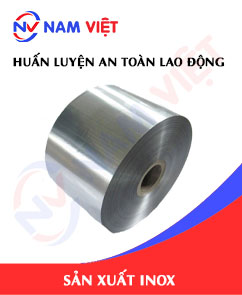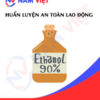Occupational Safety Training For Stainless Steel Manufacturing
99,000 ₫
Note: The above price is calculated for one person, the price may fluctuate depending on the number of trainees participating in the course and the movement of the market. For more accurate pricing support, please refer to the quotation or contact directly with our consultants.
Occupational safety is an important issue in stainless steel manufacturing factories and needs to be addressed promptly to ensure the health and safety of workers, as well as to enhance the reputation of enterprises. The Occupational Safety Training course is one of the effective solutions to raise awareness about preventing occupational accidents for workers participating in stainless steel manufacturing.
Table of Contents
Toggle1. Overview of Stainless Steel
a. What is Stainless Steel?
Stainless steel (also known as inox) is an alloy of iron with main components including iron (Fe) and other metals such as Chromium (Cr), Nickel (Ni), Molybdenum (Mo), Titanium (Ti), Vanadium (V), Silicon (Si), etc. It is called stainless because it is highly resistant to rust and chemical corrosion compared to ordinary steels.
Stainless steel is widely used in industries such as machinery manufacturing, household appliances, kitchenware, mortar and pestle manufacturing, medical equipment, food, chemical, and pharmaceutical industries.

b. Types of Machinery for Stainless Steel Manufacturing
There are many types of machinery used in stainless steel manufacturing, depending on each manufacturing stage. However, some main machines include:
- Stainless steel rolling machines: Used to roll stainless steel into sheets of specific thickness and size.
- Stainless steel cutting machines: Used to cut stainless steel into various sizes according to manufacturing needs.
- Stainless steel welding machines: Used to weld stainless steel sheets into finished products.
- Stainless steel processing machines: Include milling machines, lathes, grinders, drills, bending machines, and stamping machines to process stainless steel parts into finished products such as household items, industrial accessories, and interior decorations.
- Stainless steel polishing machines: Used to polish stainless steel, creating a smooth and shiny surface on the products.

c. Stainless Steel Manufacturers in Vietnam
In Vietnam, there are many companies producing and trading stainless steel products. Some well-known stainless steel manufacturers include:
- Inox Vietnam: One of the pioneering companies in stainless steel manufacturing and trading in Vietnam. Headquartered in Ho Chi Minh City with a factory in Binh Duong province.
- Inox Hoa Binh: A reputable company specializing in manufacturing and supplying stainless steel products in Vietnam. Headquartered in Hanoi with a manufacturing factory in Hoa Binh province.
- Minh Tan Stainless Steel Trading and Manufacturing Co., Ltd.: An experienced company in producing and supplying high-quality stainless steel products in Vietnam. Headquartered in Ho Chi Minh City with a factory in Dong Nai province.
- Hung Phuc Stainless Steel Co., Ltd.: A leading company in Vietnam producing and supplying high-end stainless steel products. Headquartered in Ho Chi Minh City with a factory in Binh Duong province.
- Hoang Thien Phat Stainless Steel Co., Ltd.: A leading enterprise in Vietnam in producing and supplying high-end stainless steel products. Headquartered in Ho Chi Minh City with a factory in Binh Duong province.

d. Specific Jobs in a Stainless Steel Factory
Group 1
- Executive director, deputy executive director, department heads in the stainless steel manufacturing factory.
Group 2
- Safety officers: manage safety in the factory, design safety procedures, supervise and enforce employee compliance with safe working procedures.
Group 3
- Cutting and processing: This includes using laser cutters or water jet machines to cut stainless steel sheets into different sizes and shapes. Then, sheets are processed using tools such as milling machines, lathes, or planers to achieve the final shape.
- Welding: Involves welding stainless steel sheets together to create final products such as frames, furniture, refrigerators, pipelines, toilets, etc.
- Polishing: Using polishing tools to create smooth and shiny surfaces on stainless steel products.
- Quality inspection: Includes checking the quality of stainless steel products using methods such as thickness measurement, hardness, durability, and flatness inspection.
- Packing and delivery: Involves packaging stainless steel products and transporting them to customers. Packaging may include foam, bubble wrap, and plastic bags to protect products during transportation.
Group 4
- Office work, services, sales, and marketing.
- Manufacturing management, quality management, human resources management, material management, financial and accounting management.

2. Overview of Occupational Safety Training for Stainless Steel Manufacturing
In this article, we focus on Group 3, because Group 3 directly participates in the manufacturing process and faces the highest occupational safety risks. For information on other groups, see here.
a. What is Group 3 Occupational Safety Training?
- Group 3 Occupational Safety Training are sessions designed to equip workers with awareness of how to prevent workplace accidents.
- The training course helps workers recognize and avoid hazards, reducing the risk of accidents during work.
REGISTER FOR OCCUPATIONAL SAFETY TRAINING SERVICE
b. Training Duration
Initial Safety Training
- Total training time is at least 24 hours, including testing time.
- 8 hours of theory on safety, hygiene policies and laws
- 8 hours of theory on basic occupational safety and hygiene knowledge
- 4 hours of theory on specialized training content
- 2 hours of practice on specialized training content
- 2 hours of final theory exam
The safety training center will distribute the time into multiple sessions depending on the workers’ schedule. Usually, there are 6 training sessions over 3 days, provided the manufacturing company arranges continuous study time.
Periodic Safety Training
- Before the occupational safety card expires, workers who want a renewal must undergo periodic occupational safety training, with the periodic training duration at least 50% of the initial training duration.
Explanation: The total duration of periodic occupational safety training is at least 12 hours, including testing time. After completing the course and passing the exam, the worker will receive a renewed occupational safety card.
c. Training Content
| No. | TRAINING CONTENT | TRAINING DURATION (HOURS) | |||
| Total | Including | ||||
| Theory | Practice | Exam | |||
| I | Safety and hygiene policies and laws | 8 | 8 | 0 | 0 |
| 1 | Overview of legal documents on occupational safety and hygiene. | 6 | 6 | ||
| 2 | Standards and technical regulations on occupational safety and hygiene. | 1 | 1 | ||
| 3 | Specific regulations of state management agencies on safety and hygiene when constructing, expanding, or renovating facilities, and for manufacturing, usage, storage, and inspection of machines, equipment, materials, and substances with strict safety and hygiene requirements. | 1 | 1 | ||
| II | Basic occupational safety and hygiene knowledge | 8 | 8 | 0 | 0 |
| 1 | Basic knowledge of hazardous and harmful factors in the workplace. | 4 | 4 | ||
| 2 | Methods to improve working conditions. | 1 | 1 | ||
| 3 | Safety culture in manufacturing and business. | 1 | 1 | ||
| 4 | Rights and obligations of employers and employees; occupational safety policies and regulations; functions and duties of safety officers. | 1 | 1 | ||
| 5 | Occupational safety rules, safety and hygiene signs, use of safety equipment and personal protective equipment; first aid skills and occupational disease prevention. | 1 | 1 | ||
| III | Specialized training content | 6 | 4 | 2 | 0 |
| Comprehensive knowledge of machines, equipment, substances generating hazardous factors; risk assessment and management; safe working procedures with machines, equipment, and substances requiring strict safety and hygiene control. | 6 | 4 | 2 | ||
| IV | Final safety training assessment | 2 | 2 | 0 | 0 |
| Total | 24 | 22 | 2 | ||
See more training content of 6 groups
d. Occupational Safety Card
After completing the occupational safety training and passing the exam, workers will be issued an occupational safety card (commonly called occupational safety certificate for Group 3).
The Group 3 safety card displays personal information such as name, date of birth, job, and work environment. It also includes training duration, red stamp, and signature confirming course completion.
According to Clause 2 of Article 24 of Decree 44/2016/ND-CP, there are two cases:
- If the employer and employee have a labor contract, the employer must sign and stamp the safety card for the Group 3 worker after completing training from an occupational safety training unit and passing the exam.
- If the worker is freelance or seasonal, without a labor contract, the training unit must sign and stamp the safety card after the worker completes the training and passes the exam.

3. Identifying Hazards Affecting Workers During Stainless Steel Manufacturing
During the process of stainless steel manufacturing and processing, there are several potential hazards that may affect the health and safety of workers. Below are some hazards that need to be recognized:
- Risk of Fire and Explosion: During stainless steel manufacturing and processing, chemicals such as acetylene, propane, methane gas, and oxygen are used in welding, cutting, and processing. Improper use of these substances can cause fire and explosion, threatening the life and health of workers.
- Risk of Occupational Accidents: During stainless steel processing and manufacturing, equipment and machinery may cause accidents such as cuts, crushing, collisions, or entrapment. Working at heights or on slippery surfaces may also lead to accidents.
- Electrical Hazards: If electrical equipment in the factory is not regularly maintained, properly insulated, or waterproofed, it can pose the risk of electric shock to workers during manufacturing.
- Risk of Pollution: During stainless steel manufacturing and processing, chemicals and toxic gases may be generated, causing air pollution and harming workers’ health.
- Risk of Skin Injuries: Stainless steel manufacturing and processing can cause skin injuries, including cuts, burns, or dermatitis. Contact with chemicals or improper use of tools and equipment can also cause skin damage.

4. Common Occupational Accidents For Workers During Stainless Steel Manufacturing
Common occupational accidents that may occur for workers during stainless steel manufacturing include:
- Cutting and Injury Accidents: During cutting, packaging, and transporting stainless steel, tools such as knives, scissors, cutting machines, grinding machines, bending machines, rolling machines, stamping machines, and pressing machines are used. The risk of cuts and injuries is high if safety rules are not followed.
- Chemical Pollution: Chemicals such as acids, alkalis, solvents, additives, and dyes may be used to treat, bleach, polish, or dye stainless steel products. Improper use or lack of protective measures may harm workers’ health.
- Electrical Accidents: During manufacturing and use of stainless steel, workers may come into contact with electrical wires and equipment. Failure to follow electrical safety rules can result in a high risk of electric shock.
- Heavy Metal Poisoning: Heavy metals such as lead, cadmium, and mercury may be present in stainless steel materials and products. Workers exposed to these substances without proper protection may suffer from heavy metal poisoning.
- Chemical Accidents: Chemicals used in stainless steel manufacturing and processing may explode, catch fire, or release toxic gases if not used correctly.
- Other Occupational Accidents: Besides the above, workers in stainless steel factories may face other risks, such as falling objects, elevator accidents, back injuries from lifting heavy loads, and traffic accidents during material transportation.

5. Safety Measures When Participating In Stainless Steel Manufacturing
Safety measures when participating in stainless steel manufacturing include:
- Wearing Full Personal Protective Equipment: Workers should wear helmets, masks, safety glasses, gloves, and safety shoes.
- Proper Machine Configuration: Stainless steel manufacturing machinery must be properly configured before use to minimize accident risks.
- Regular Machine Inspections: Conduct regular inspections to ensure machinery operates safely and efficiently.
- Labor Safety Training: Train employees on proper use and maintenance of equipment and machinery.
- Providing Chemical Safety Information: Ensure employees understand the chemicals used and are instructed on their safe handling.
- Proper Waste Management: Implement proper waste disposal procedures to minimize environmental and worker risks.
- Safe Working Conditions: Provide safe working conditions, including adequate ventilation, lighting, and cleanliness, to reduce accident and illness risks.
- Regular workplace environment monitoring in factories to collect and analyze harmful factors for workers, then adjust to reduce hazards and prevent occupational diseases.
6. Benefits Of Labor Safety Training In Stainless Steel Manufacturing
An Toan Nam Viet provides your company with the following benefits upon completing labor safety training courses in accordance with Decree 44/2016/ND-CP on Occupational Safety and Hygiene:
- Workers can recognize potential accident hazards and take preventive measures to avoid occupational accidents.
- Your company can establish risk prevention measures in manufacturing, operation, and maintenance processes.
- Reduce costs associated with workplace safety incidents.
- Uninterrupted manufacturing helps increase labor productivity and product quality.
- Ensure compliance with labor safety regulations and avoid legal risks.
- Enhance corporate reputation and professionalism, boosting your brand image.
Nam Viet’s training courses are solutions to prevent external hazards, enabling individuals to avoid injuries or even fatal accidents.
REGISTER FOR LABOR SAFETY TRAINING SERVICE
7. Customer Feedback After Completing Labor Safety Training In Stainless Steel Manufacturing
An Toan Nam Viet has many years of experience supporting enterprises across Vietnam, particularly in the southern provinces. This responsibility is highly valuable to Nam Viet, which is why our Labor Safety Training programs are increasingly professional. The motivation for our growth comes from positive feedback and suggestions from companies. Below are feedbacks from our partners.
See more customer interviews after using An Toan Nam Viet services
8. An Toan Nam Viet Labor Safety Training Capability
An Toan Nam Viet is a reputable and high-quality labor safety training center in Vietnam, conducting training continuously at factories, workshops, or construction sites nationwide (63 provinces).
REGISTER FOR LABOR SAFETY TRAINING SERVICE
Labor Safety Training License
- An Toan Nam Viet has been inspected and certified by the Department Of Labor Safety Under The Ministry Of Labor, Invalids And Social Affairs, confirming our eligibility for labor safety and hygiene training, strengthening our training capabilities.

Training Materials And Lectures
- Before being used in labor safety training courses, materials are reviewed to ensure accuracy and effectiveness.
- Instructors follow teaching methods standardized by An Toan Nam Viet, based on experts’ research in occupational safety and hygiene training to maximize learners’ knowledge absorption.
Facilities
- Controlling classroom factors improves teaching efficiency and learners’ knowledge retention.
- Our Training Facilities are spacious and meet standards in area, lighting, and equipment.
9. Nationwide Reputable Labor Safety Training Center
At An Toan Nam Viet, we prioritize professional labor safety training. Educating workers to protect themselves contributes to national development.
To ensure effective training, we carefully prepare all materials, tools, equipment, and environment.
Our labor safety instructors are experts with years of experience, even conducting research to identify workplace hazards and preventive measures.
Lectures are practical and engaging, helping workers comfortably absorb knowledge while complying with Decree 44/2016/ND-CP.
Our Training Center is proud to offer professional labor safety training with advantages:
- Competitive training costs while maintaining quality.
- Flexible training schedules accommodating company manufacturing.
- Fast certification procedures following legal regulations.
- Experienced instructors with extensive industry knowledge.
- Controlled classrooms enhance teaching efficiency and learner retention.
- Training materials tailored to enterprise labor safety requirements.
- An Toan Nam Viet provides dedicated, professional support to clients efficiently and accurately.

10. Additional References For Labor Safety Training In Stainless Steel Manufacturing
- Labor Safety Training Materials For Stainless Steel Manufacturing
- Labor Safety Training Material Set
- Labor Safety Test Set
- Labor Safety Training Curriculum For Stainless Steel Manufacturing
- Labor Safety Multiple-Choice Test For Stainless Steel Manufacturing
1 review for Occupational Safety Training For Stainless Steel Manufacturing
No comments yet















namchinh.haiphong341
Bài giảng rất sinh động!